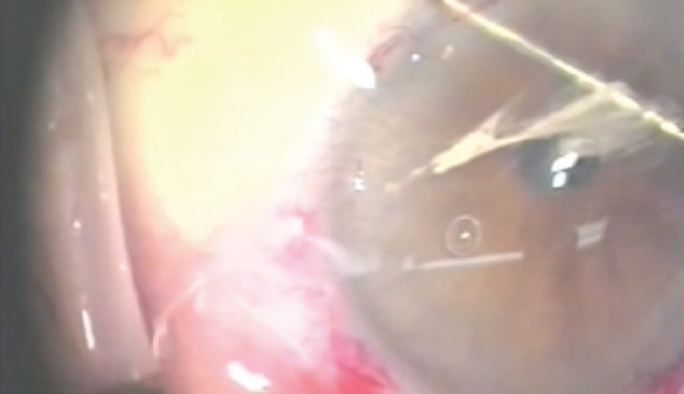
Whatever your experience with or preferred incisional approach to anterior vitrectomy—be it biaxial anterior incisions or a one-port pars plana incision with irrigation anteriorly—several steps are critical to success. First and foremost, it is essential to develop a plan before the moment of crisis and to have at the ready the tools with which to execute that plan.
PRACTICE
Your skillfulness with pars plana incisions, trocar systems, and alternative techniques for implanting a stable IOL increases your ability to offer cataract surgery patients the best outcomes despite a complication. Your understanding of optimal machine settings and your facility with the footpedal are critical. Similarly, your staff must know how to find all of the tools you require during a vitrectomy and how to set up the vitrectomy machine.
Preparation requires practice. For years, I have recommended periodically calling a code V at the end of a surgical day when equipment is still available. Additionally, I would suggest practicing infrequently used skills on artificial eyes.
EARLY ACTION
The earlier you recognize a complication and limit the potential resulting cascade, the better the result will be. If the posterior capsule tears without rupturing the anterior hyaloid membrane, converting to a continuous posterior capsulorhexis—an important skill to learn—promotes an optimal outcome (see Watch It Now).
Rupture of the anterior hyaloid membrane with vitreous prolapse into the anterior segment changes the risk of late complications. The greater surgical manipulation required will create the potential to cause more harm, not to mention that you are now operating in a one-chambered eye. Once vitreous has been lost through incisions, the likelihood of a retinal tear or detachment increases, and you must act to create a stable, closed intraocular system. Depending upon the timing, residual nuclear fragments may be a concern, and you must know how to isolate them from the vitreous for removal and when to leave them for another day.
CARDINAL PRINCIPLES
A successful anterior vitrectomy adheres to a set of cardinal principles. Chief among them is avoiding intra- and postoperative vitreous traction because the peripheral retina is 100 times thinner than the posterior retina. Traction on prolapsed anterior vitreous will result in tears and detachment. Maneuvering instruments and devices through vitreous or using improper machine settings can produce traction.

Figure. Attempting to drag entrapped vitreous out of the incision increases traction.
Some maneuvers you might have learned can betray you. Although classically taught, a sweep from the sideport incision to drag entrapped vitreous out of the main incision increases traction on the connection through the pupil instead of efficiently freeing incarcerated vitreous (Figure and Watch It Now). Wicking entrapped vitreous strands with a cellulose sponge is similarly problematic. (Editor’s note: For more on the dangers of cellulose sponge use, see “Anterior Vitrectomy: Concepts From a Retina Specialist.”) A better method is to amputate anterior-posterior prolapsed vitreous connections with the vitrector. Once connection to the vitreous body is eliminated, such strands and sheets can be easily removed without consequences to the retina (see Watch It Now).
ENHANCE YOUR ANTERIOR VITRECTOMY SKILLS
Dr. Arbisser demonstrates her technique for conversion of a capsular tear to a posterior continuous curvilinear capsulorhexis.
Dr. Arbisser demonstrates a pars plana vitrectomy sweep technique.
Depiction of the behavior of vitreous during vitrectomy.
To avoid hypotony and wide swings in pressure, maintain a normotensive globe by creating tightly fitting, closed incisions; properly managing inflow and outflow; and using OVDs judiciously. Variations in IOP promote choroidal effusion and catastrophic suprachoroidal hemorrhage. Vitreous follows along a high-to-low pressure gradient, so it is essential to prevent anterior chamber collapse in order to avoid repeat prolapse and postoperative traction from the contraction of vitreous strands that attach to anterior chamber structures.
Focus on your goal: to remove prolapsed vitreous that may adhere to anterior structures or incisions. A secondary goal, per Abhay R. Vasavada, MS, FRCS, is to remove vitreous to a uniform degree behind the IOL. This maneuver helps to prevent tilt while minimally disturbing the unaffected parts of the structure.
Never fish around or within the vitreous. Not typically visible in vivo, the vitreous body is composed of solid parts (cortex, septa, and cisternal walls) and separate, more liquid parts (canals, cisterns, and spaces). Collagen fibrils and fibers interact with hyaluronic acid; formed vitreous and the lamellae are interconnected by a loose mesh of fibers. The high-water, low-protein content is unique in the body. This complex structure you are manipulating acts like a toy slinky attached to wallpaper (ie, the retina). Placing instruments other than a vitrector into the vitreous body to retrieve lens fragments courts disaster. Refer the patient for a total vitrectomy or a lensectomy if nuclear fragments are lost into the posterior segment.
VISUALIZATION
The use of preservative-free triamcinolone acetonide (Triesence, Alcon) allows you to visualize otherwise invisible vitreous. When instilled intracamerally, the suspended particles are individually trapped in the vitreous matrix but will rinse out of aqueous. Triamcinolone acetonide will not adhere to an OVD but can be blocked by it. Triesence is best diluted 10:1 with balanced saline solution to prevent a whiteout effect within the anterior chamber that obscures intraocular structures. The dilution should also provide enough volume for repeated use during the case.
In the best of all worlds, prepared preservative-free triamcinolone acetonide would be in the OR ready for use at the moment you suspect a complication has occurred. That, however, is unlikely to be the case. Instead, an OVD can be used to stabilize the environment, and an injection of triamcinolone acetonide after the initial vitrectomy and OVD removal can provide a critical visual endpoint for vitrectomy.
In a complicated case, instill 1 or 2 minims of preservative-free triamcinolone acetonide into the anterior chamber as one of your last maneuvers to rule out unsuspected vitreous presentation. An added benefit of this drug is that it reduces postoperative inflammation.
LAST STEPS AND POSTOPERATIVE CARE
Dealing with vitreous is no justification for losing much-needed capsular support, chewing up iris tissue, or causing corneal edema by failing to protect the endothelium. Whenever possible, it is important to leave a clean anterior segment and bag, a stable lens implant, and a clear visual axis for rapid visual rehabilitation or timely further management if required.
Your management strategy must extend to the postoperative period. Aggressive management of inflammation with topical steroids and NSAIDs is essential.
The risk of endophthalmitis increases dramatically after an unplanned vitrectomy. I therefore recommend the off-label use of intracameral moxifloxacin whenever vitreous is lost.
Because the aggressive removal of an OVD can encourage vitreous presentation, viscoelastic material will inevitably be left behind. That, combined with the extended case time and dispersed antigenic lens fragments, can cause a (likely transient) postoperative increase in IOP. Hypertensive prophylaxis is therefore advisable immediately after surgery, especially because an anterior chamber tap for high pressure on day 1 increases the risk of repeat vitreous prolapse.
CONCLUSION
Every patient who undergoes complicated cataract surgery deserves full disclosure, close observation, a timely retinal evaluation with scleral depression, and a referral to a retina specialist as appropriate. (Editor’s note: For more on this topic, see “Retinal Complications: Refer or Comanage?.”) Explain to these patients that they are at increased risk of developing a retinal tear or detachment, glaucoma, and cystoid macular edema. By providing your emergency contact information and encouraging them to use it if necessary, you empower patients in their own care.




